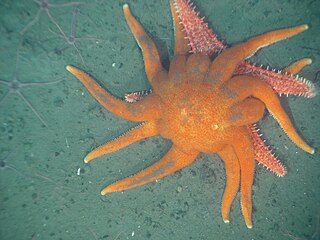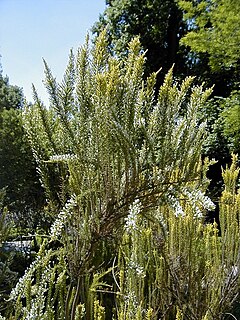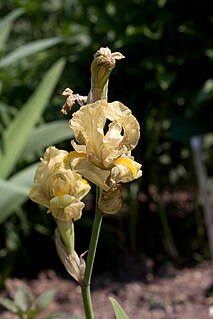
Pinctada is a genus of saltwater oysters, marine bivalve mollusks in the family Pteriidae. These pearl oysters have a strong inner shell layer composed of nacre, also known as "mother of pearl".

Lactuca, commonly known as lettuce, is a genus of flowering plants in the family Asteraceae. The genus includes at least 50 species, distributed worldwide, but mainly in temperate Eurasia.

Cylindropuntia imbricata, the cane cholla, is a cactus found in the Southwestern United States and northern Mexico, including some cooler regions in comparison to many other cacti. It occurs primarily in the arid regions of the Southwestern United States in the states of Kansas, Oklahoma, Texas, New Mexico, Arizona, Colorado, and Nevada. It is often conspicuous because of its shrubby or even tree-like size, its silhouette, and its long-lasting yellowish fruits.

The Valvatida are an order of starfish in the class Asteroidea, which contains 695 species in 172 genera in 17 families.

Fabiana imbricata, or pichi, is a species of flowering plant in the family Solanaceae, native to dry upland slopes in Chile and Argentina. Growing to 2.5 m tall and wide, it is a frost-hardy, heath-like evergreen mound-forming shrub. It has needle-like leaves and small white, tubular flowers in early summer.

Morelia imbricata is a large snake found in southern regions of Western Australia and western South Australia. A member of the python family, it is commonly known as the southwestern carpet python.

Arctostaphylos imbricata is a species of manzanita known by the common name San Bruno Mountain manzanita.

The hawksbill sea turtle is a critically endangered sea turtle belonging to the family Cheloniidae. It is the only extant species in the genus Eretmochelys. The species has a worldwide distribution, with Atlantic and Indo-Pacific subspecies—E. i. imbricata and E. i. bissa, respectively.

Tinea imbricata is a superficial fungal infection of the skin limited to southwest Polynesia, Melanesia, Southeast Asia, India, and Central America. The skin lesions are often itchy, and mainly in the torso and limbs. The name is derived from the Latin for "tiled" (imbricata) since the lesions are often lamellar. It is often treated with griseofulvin or terbinafine.

Fabiana is a genus of flowering plants in the nightshade family, native to dry slopes in western South America. They are evergreen shrubs or subshrubs, with needle-like leaves and profuse tiny tubular flowers in summer. The common name is false heath because the leaves superficially resemble those of the distantly related heaths. The species F. imbricata is cultivated as a common horticultural plant and a common herbarium specimen.

The Sri Lanka thrush or Sri Lanka scaly thrush is a member of the thrush family Turdidae. This bird is a non-migratory resident breeder found in south western rainforests of the island of Sri Lanka.

Hydrostachys is a genus of about 22 species of flowering plants native to Madagascar and southern and central Africa. It is the only genus in the family Hydrostachyaceae. All species of Hydrostachys are aquatic, growing on rocks in fast-moving water. They have tuberous roots, usually pinnately compound leaves, and highly reduced flowers on dense spikes.
H. imbricata may refer to:

Arca imbricata, or the Mossy ark clam, is a clam in the family Arcidae. It can be found along the Atlantic coast of North America, ranging from North Carolina to the West Indies, Brazil, and Bermuda.

The leather star is a sea star in the family Asteropseidae found at depths to 100 m (328 ft) off the western seaboard of North America. It was first described to science by Adolph Eduard Grube in 1857.
Concavodonta is an extinct genus of early bivalve in the extinct family Praenuculidae. The genus is one of three genera in the subfamily Concavodontinae. Concavodonta is known solely from late Ordovician, Caradoc epoch, fossils found in Europe and South America. The genus currently contains three accepted species, Concavodonta imbricata, Concavodonta ovalis and the type species Concavodonta ponderata.

Cylindropuntia spinosior, with the common names include cane cholla, spiny cholla and walkingstick cactus, is a cactus species of the North American deserts.

Iris imbricata is a species in the genus Iris, it is also in the subgenus Iris. It is a rhizomatous perennial, from the Caucasus mountains, within Iran, Armenia, Azerbaijan and Georgia. It has broad, sword-like, yellow green or light green leaves, slender stem with branches, inflated and overlapping green spathes, and 2–5 yellow, pale yellow or greenish yellow flowers.

The Amazon–Orinoco–Southern Caribbean mangroves (NT1401) is an ecoregion along the coasts of Colombia, Venezuela, Guyana, Suriname, French Guiana and Brazil.

Petrophile imbricata is a species of flowering plant in the family Proteaceae and is endemic to southwestern Western Australia. It is a shrub with overlapping, needle-like leaves and oval heads of hairy cream-coloured flowers.


















